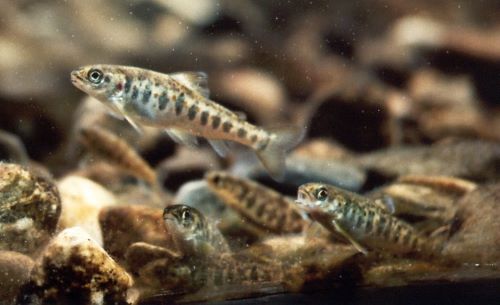The Maine Department of Marine Resource’s Sea-run Fisheries and Habitat Bureau has received $5.9 million to improve habitat for endangered Atlantic salmon in Maine rivers that hold the last remaining populations of the iconic species.
The funds, from the U.S. Department of Agriculture’s Regional Conservation Partnership Program (RCPP), will support improvements in habitat diversity, habitat cover, and substrate to create spawning and rearing habitat in the eight Maine rivers that hold the Gulf of Maine Distinct Population Segment (DPS), which has been listed as Endangered under the US Endangered Species Act since 2000.
This project will also promote populations of wild brook trout and other sea-run species such as eels and sea-lamprey.
“This type of habitat restoration offers high-impact aquatic habitat conservation benefits, with enormous potential to improve in-stream habitat, stream function and productivity, and to counteract lasting detrimental effects of log drives in Maine rivers,” said Sean Ledwin, Director of DMR’s Searun Fisheries and Habitat Bureau.
Atlantic salmon and brook trout need complex in-stream structures for healthy habitat. “Trees that naturally fall into rivers play a vital role for salmon and trout survival,” said Ledwin. “When the trees fall into rivers or streams, their trunks dig deep pools, and cause gravel to settle, creating ideal substrate for salmon and trout to lay eggs. Young salmon use the pools to feed and grow before their outmigration to the sea. Native brook trout use the habitats year-round.”
Maine’s log drive era from the 1700s to the 1970s changed the structure of many rivers and streams in Maine.
They were straightened and widened, and logs and boulders that are integral to good salmon habitat were removed to facilitate the wood drives.
As a result, pools and the course gravel that salmon use for spawning have been reduced or eliminated from many waterways in Maine.
In addition, forest harvesting in some areas has destabilized riverbanks and eliminated shade necessary to keep water cool, which is also critical for salmon and brook trout habitat.
The work will involve installation of large natural wood and rock structures that will improve riverbed substrate, as well as restoration or enhancement of areas along rivers and streams that provide shade and prevent erosion which can reduce oxygen levels that native fish need to survive.
Beyond the environmental outcomes, this project will also yield important social benefits. “The restoration of traditional cultural, economic, and recreational practices through increases in anadromous fish populations over time will be extremely important to Maine’s federally recognized tribes that have occupied and stewarded the area now called Maine for millennia,” said Ledwin.
Restored stream channels and native vegetation in riparian corridors will also increase the aesthetic value of Maine rivers, encouraging recreational activities including kayaking, canoeing, fishing, and other recreational endeavors.
source: Maine Department of Marine Resources
